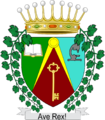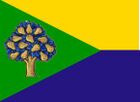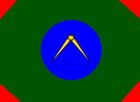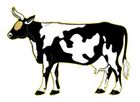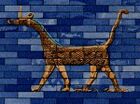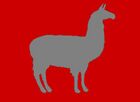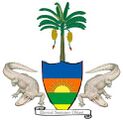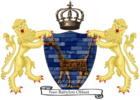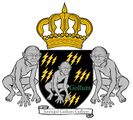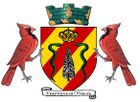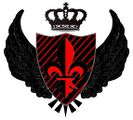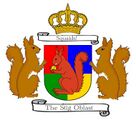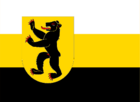National symbols of Gishabrun
The national symbols of Gishabrun, in its incarnations as a Tsarist Empire, a SAR of Renasia, and a non-territorial entity, are listed below.
Flag
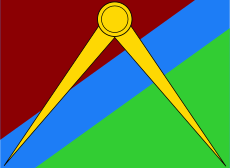 |
|
| Use | Civil and state flag and ensign |
|---|---|
| Proportion | 4:3 |
| Adopted | 5 April 2010 |
| Design | A diagonal tricolour, divided with a blue diagonal band extending from the lower hoist-side corner. The upper triangle is maroon and the lower triangle is light green. On top of it all is a yellow drafting compass with its hinge at the upper middle of the flag and its points extending to either bottom corner of the flag. |
| Designed by | HIM Tsar Kuri I |
 |
|
| Use | War flag and naval ensign |
| Proportion | 4:3 |
| Adopted | May 2010 |
| Design | A diagonal tricolour, divided with a blue diagonal band extending from the lower hoist-side corner. The upper triangle is maroon and the lower triangle is light green. On top of it all is a white sword, positioned horizontally with its tip to the fly side. |
| Designed by | HIM Tsar Kuri I |
The national flag of Gishabrun consists of 3 diagonal stripes, each symbolising one of the three official principles that lead to the founding of the Tsarist Empire:
- Maroon represents patriotism, courage, effort and preservation of culture.
- Blue represents hope, truth, freedom and correct government.
- Green represents discovery, wilderness and environmental legacy.
The yellow compass represents the fourth, unofficial principle, which is the advancement of scientific knowledge.
The flag of Gishabrun used today is slightly different from the original version adopted by the Tsardom of Moya Kravat, shown below. The flag of Moya Kravat had a key added to symbolise the Tsar's room. This key was removed after the Furnace War and the conquest of Annina Kravat.
-
Flag of the Tsardom of Moya Kravat
The Tsarist Empire of Gishabrun also had a war flag, which was identical to the national flag, except that the yellow compass was replaced with a horizontal white sword to symbolise war. It fell into disuse with the absorption of Gishabrun into Renasia on July 22nd, 2012.
Coat of Arms

The coat of arms of the Tsarist Empire of Gishabrun, officially the personal armorial achievement of HIM Tsar Kuri I, had the same symbolism as the national flag, together with the following elements:
- White represented purity and justice in equal partnership with Blue (checkered design).
- Pear Trees represented wildlife conservation and the fruits of labour. A pear tree also grew in the Imperial Garden, Kravat Oblast.
- Crown represented the monarch and monarchy.
- Herons represented environmental legacy and that the environment supports us in every way. Herons are native to the area of what was Wild Isle Krai.
- Motto The motto is "וְאָכַלְתָּ וְשָׂבָעְתָּ", which is a Hebrew quote from Deuteronomy 8:10 that means "You shall eat, and you shall be satisfied". The symbolism of this motto is that we should take only what we need and be satisfied with what we have.
This coat of arms was fairly different from the coat of arms of the Tsardom of Moya Kravat, shown below.
-
Arms of the Tsardom of Moya Kravat
The coat of arms of Gishabrun was replaced by the Seal of Gishabrun (see below) upon the adoption of the Gishabrun SAR Constitution of July 22nd, 2013.
Seal

The Seal of Gishabrun is the official symbol of Gishabrun since July 22nd, 2013. It was described in the Gishabrun SAR Constitution (Section 6, Article 2) as "a monochrome design displaying the lower half of the Renasian broken circle in the lower half of the seal and two horizontal lines in the upper half, curving as if enclosed by a circle".
This unique seal design was inspired by Japanese Mon, or family crests. The symbolism of the two lines in the top half of the seal is unknown, while the bottom half represents Gishabrun SAR's union with Renasia. Despite this symbolism, the seal has been retained as the official symbol of non-territorial Gishabrun.
National Anthem
The national anthem of the Tsarist Empire of Gishabrun in peacetime was Hail the Tsar!. It was sung to the tune of the State Anthem of the Republic of Kalmykia, with lyrics written by HIM Tsar Kuri I. It was adopted by the Elite Duma on January 25th, 2011, with the following lyrics:
Gishabrun, ye mighty Tsarist Empire
How we adore our great Fatherland!
Our superior flag will forever fly,
Gishabrun's glorious standard.
Hail the Tsar and unite to form
The greatest of the world!
Our Tsar Kuri will reign
Til the pebbles become boulders!
Hail the Tsar and secede from the oppressors
That occupy our rightful lands.
Hail the Tsar and respect all the diverse cultures
To ensure that Gishabrun survives forever...
The wartime anthem of the Tsarist Empire, Sacred War, was composed by Alexander Alexandrov and had no lyrics. In practice, this anthem was never used.
Upon the adoption of the Gishabrun SAR Constitution of July 22nd, 2013, the anthem of Gishabrun was changed to Immortal Victims, which had no lyrics. When Gishabrun transitioned to a non-territorial entity, no official anthem was specified in the original decree establishing the national symbols.
National Animal

The national animal of the Tsarist Empire of Gishabrun was the Great Blue Heron (Ardea Herodias), because it symbolises environmentalism and sustainability (one of the three official principles), and it symbolises patience (because it must wait a long time to catch its meal of fish).
National Tree
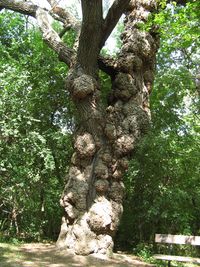
The national tree of the Tsarist Empire of Gishabrun was the Black Willow (Salix Nigra), because it is common in what were Gishabruni land claims (the most famous example being the Ancient Willow in Ancient Willow Krai). It also symbolises environmentalism and sustainability, as well as maturity and reliability.
National Flower
The national flower of the Tsarist Empire of Gishabrun, determined by the Clan Council in May of 2011, was the Bleeding Heart (Lamprocapnos spectabilis). It is native to East Asia, but was grown as a garden plant in the Imperial Garden, Kravat Oblast.
National Dish
The national dish of the Tsarist Empire of Gishabrun was the "grenka", a savoury Russian variant of french toast. It was made by soaking a slice of bread in raw eggs and frying it.
National Sport
The national sport of the Tsarist Empire of Gishabrun was chess, which was very popular among its citizen body. The Tsarist Empire of Gishabrun was a member of the Intermicronational Chess Federation, and was the host nation for the 2010 Intermicronational Chess Championship. Chess continued to be popular in Gishabrun SAR, with Gishabruni players winning 1st and 2nd place for Renasia in the 2012 Micronational Chess Championship.
Sub-national flags and arms
Oblast flags
-
Flag of Kravat Oblast
-
Flag of Somewhere Oblast
-
Flag of Eternal Summer Oblast
-
Flag of Stay Out Oblast
-
Flag of Potatoman's Room Oblast
-
Flag of Canis Majoris Oblast
-
Flag of Neo Babylon Oblast
-
Flag of Encaladus Oblast
-
Flag of Sméagol-Gollum-Gollum Oblast
-
Flag of Llama Oblast
-
Flag of Kvartirskaya Oblast
-
Flag of Soba Oblast
-
Flag of The Stig Oblast
Oblast arms
-
Arms of Kravat Oblast
-
Arms of Somewhere Oblast
-
Arms of Eternal Summer Oblast
-
Arms of Stay Out Oblast
-
Arms of Potatoman's Room Oblast
-
Arms of Canis Majoris Oblast
-
Arms of Neo Babylon Oblast
-
Arms of Encaladus Oblast
-
Arms of Sméagol-Gollum-Gollum Oblast
-
Arms of Llama Oblast
-
Arms of Kvartirskaya Oblast
-
Arms of Soba Oblast
-
Arms of The Stig Oblast
Autonomous region flags
-
Flag of the Autonomous Empire of Maccrage
-
Flag of the Autonomous Republic of Prievidzia
Autonomous region arms
-
Arms of the Autonomous Empire of Maccrage
-
Arms of the Autonomous Republic of Prievidzia

